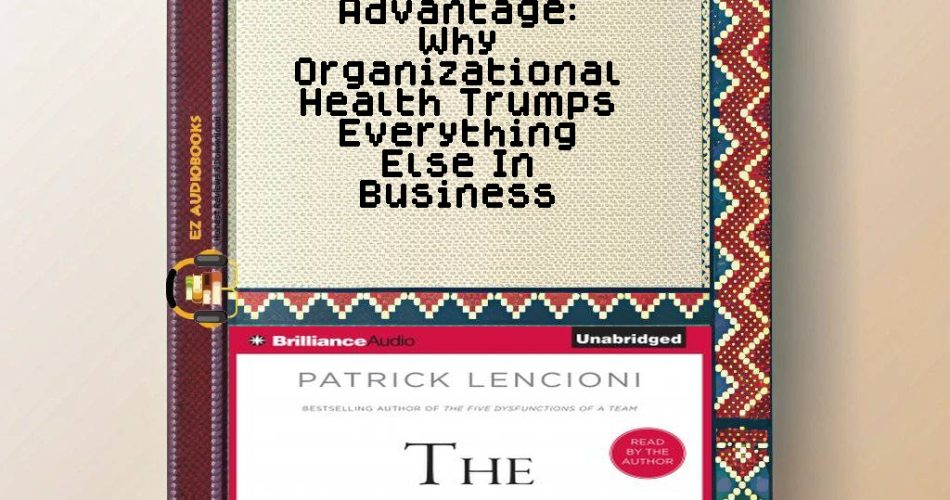Audiobook Sample
Listen to the sample to experience the story.
Please wait while we verify your browser...
- Title: Advantage: Why Organizational Health Trumps Everything Else In Business
- Author: Patrick Lencioni
- Narrator: Patrick Lencioni
- Length: 06:00:00
- Version: Abridged
- Release Date: 20/03/2012
- Publisher: Brilliance Audio
- Genre: Business & Economics, Career Development
- ISBN13: 9.78E+12
As I settled into my favorite armchair with a cup of jasmine tea – the same one where I first discovered Murakami’s magical realism – I pressed play on Patrick Lencioni’s “The Advantage” with both professional curiosity and personal anticipation. What unfolded was not just another business audiobook, but a narrative that resonated deeply with my academic fascination with how systems shape human behavior.
Lencioni’s central thesis – that organizational health surpasses intelligence as a competitive advantage – immediately reminded me of my semester teaching “Cloud Atlas” in multiple formats. Just as that novel revealed how medium affects message, Lencioni demonstrates how organizational structure fundamentally alters business outcomes. His argument that healthy organizations create environments ‘where star performers never want to leave’ echoes the cultural cohesion I observed during my research on Japanese corporate structures in Tokyo.
The audiobook’s strength lies in Lencioni’s dual role as author-narrator. His delivery carries the conviction of someone who’s lived these principles, with pacing that emphasizes key concepts without feeling didactic. I particularly appreciated how he uses vocal inflection to distinguish between theoretical framework (slightly slower, deliberate tone) and practical anecdotes (more conversational rhythm). This reminded me of the best literature professors who could make complex theories accessible through storytelling.
Through a cultural lens, what fascines me most is Lencioni’s model of organizational health as a narrative construct. His four disciplines – build a cohesive leadership team, create clarity, overcommunicate clarity, and reinforce clarity – form what we might call in literary theory a ‘corporate plot structure.’ The repetition of ‘clarity’ functions as a refrain, much like the recurring motifs in Murakami’s work that create narrative cohesion.
The audio production deserves special mention. Unlike some business audiobooks that can feel dry, this recording maintains energy through well-placed pauses and subtle background music during transitions. At 3 hours runtime, it’s concise enough for a cross-country flight (I listened during my last trip to Berkeley) yet substantive enough to warrant repeated listening.
Some limitations emerge when examining the content through an academic critical lens. While Lencioni’s anecdotes are compelling, they skew heavily toward tech and professional services firms. I found myself wishing for more examples from education or non-profits – sectors where I’ve witnessed both remarkably healthy and dysfunctionally toxic cultures. Additionally, his model assumes a certain level of organizational stability that may not account for startups or rapidly scaling companies.
Compared to similar works like Jim Collins’ “Good to Great” (which focuses more on strategic decisions) or Simon Sinek’s “Start With Why” (more philosophical in approach), Lencioni strikes a unique balance between practical framework and humanistic insight. His background as a playwright shines through in how he constructs organizational narratives – a quality that makes this audiobook particularly engaging for listeners who appreciate storytelling in business contexts.
For potential listeners, I’d recommend this audiobook to:
1. Academics studying organizational behavior (it offers excellent case studies)
2. Mid-career professionals navigating workplace dynamics
3. Entrepreneurs building company culture from scratch
Having analyzed countless narratives across media, I can confidently say Lencioni has created something special here – a business book that understands organizations as living narratives rather than mechanical systems. As I paused the recording to refill my tea, I found myself reflecting on how the healthiest academic departments I’ve worked in all embodied Lencioni’s principles unconsciously. That’s the mark of truly impactful ideas – they name what we intuitively recognize but haven’t yet articulated.
In scholarly solidarity and shared curiosity,
Prof. Emily Chen

